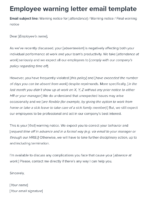Employee warning notice email template
Use this email template to send a formal, written warning notice to employees who violate your company policies. You can customize this template whether it's a first or a final warning notice.
- What is an employee warning letter?
- How to write an employee warning letter
- Employee warning letter template
Employee warning letter email template
Email subject line
Warning notice for [attendance] / Warning notice / Final warning notice
Email body
Dear [Employee’s name],
As we’ve recently discussed, your [absenteeism] is negatively affecting both your individual performance at work and your team’s productivity. We take [attendance at work] seriously and we expect all our employees to [comply with our company’s policy regarding time off].
However, you have frequently violated [this policy] and [have exceeded the number of days you can be absent from work] despite reprimands. More specifically, [in the last month you didn’t show up at work on X, Y, Z without any prior notice to either HR or your manager.] We do understand that unexpected issues may arise occasionally and we [are flexible (for example, by giving the option to work from home or take a sick leave to take care of a sick family member).] But, we still expect our employees to be professional and act in our company’s best interest.
This is your [first] warning notice. We expect you to correct your behavior and [request time off in advance and in a formal way (e.g. via email to your manager or through our HRIS.)] Otherwise, we will have to take further disciplinary action, up to and including termination.
Email sign off
I’m available to discuss any complications you face that cause your [absence at work.] Please, contact me directly if there’s any way I can help you.
Sincerely,
[Your name]
[Your email signature]
What is an employee warning letter?
An employee warning letter is a document that an employer issues to an employee to officially notify them of a breach of company protocol and to inform them of any disciplinary consequences. The employee signs the written warning to acknowledge its receipt and a copy is kept in their personnel file.
How to write an employee warning letter
A warning notice is a formal way to discipline employees about their misconducts. Misconduct may refer to:
- Unwillingness to perform job duties
- Attendance issues
- Breach of a company policy
- Other types of misdemeanors or one-time minor offenses
Take stricter measures (like suspension or termination) for serious violations such as harassment or fraud.
Related: Termination letter sample template
Depending on your company’s disciplinary action policy, it might be best to first have a manager or Human Resources representative issue a verbal warning and advise the employee on how to correct their behavior. If they don’t conform to your company’s standards, you can then send a written warning notice to emphasize the seriousness of their misconduct and explain what will happen if this behavior continues.
The purpose is to help employees understand how their misconduct impacts the company and their work, what the consequences are and how they can self-discipline so that they don’t face more serious disciplinary actions, including termination of employment. On your part, employee warning notices help you keep track of actions taken before deciding to dismiss an employee who ignores company regulations and reprimands.
Use the following employee warning notice email template as a point of reference and edit according to the type of misconduct. Make sure to include specific incidents that show how or when the employee committed a mistake at work and how this violates your company policies. If this is the first warning notice you send to an employee, ask them to meet at your office so you can further discuss the issue or suggest alternative solutions (like taking some days off if they have personal problems that affect their behavior.) If this is the final warning notice before dismissal, make that clear to employees so that they have one last chance to correct their behavior.
